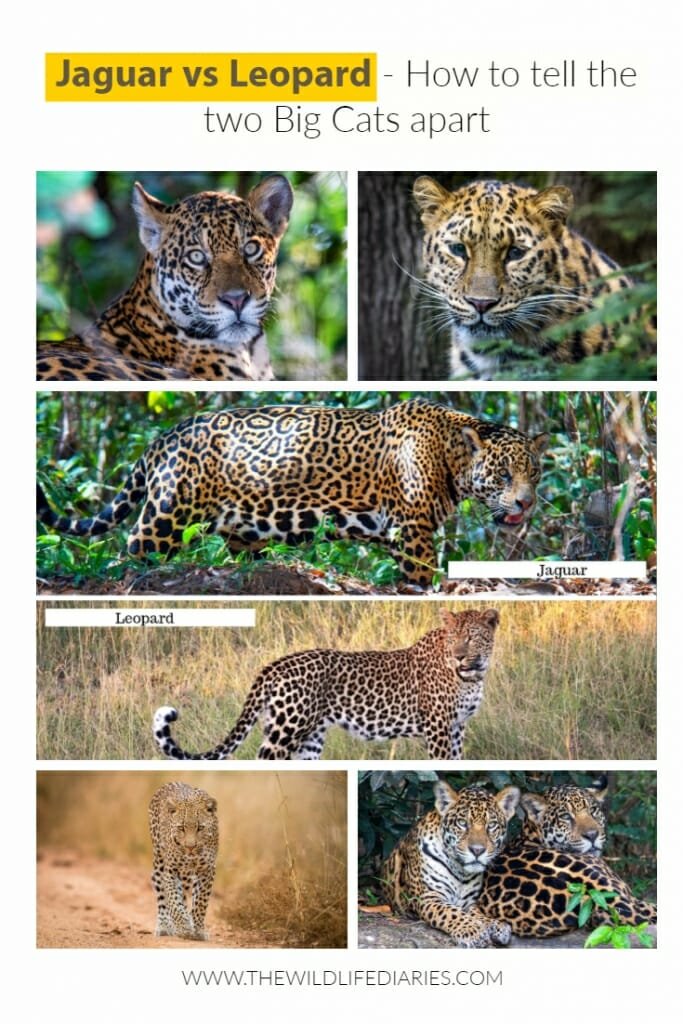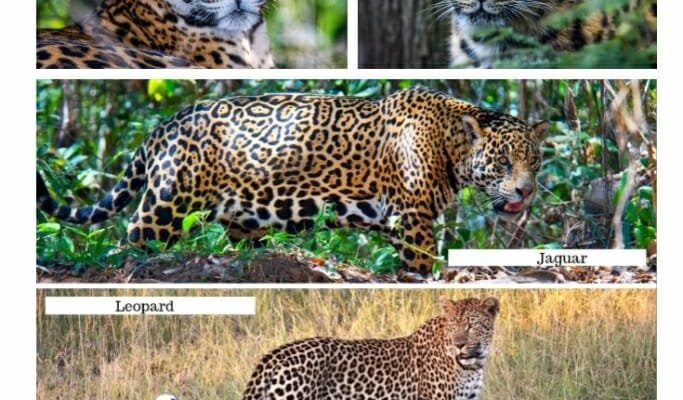
Understanding the differences can be a bit like sorting out your sock drawer: it seems simple until you dive in and realize how many variations there are. So, let’s explore ten animals that bear a striking resemblance to leopards, helping you learn how to identify them with ease. Who knows, you might surprise a friend with your newfound knowledge the next time you find yourself discussing wildlife over coffee!
1. Jaguars: The Spotty Cousin
When you think of big cats, Jaguars often come to mind right alongside leopards. Both boast a similar spotted coat, but there are some key differences. Jaguars are typically larger and heavier than leopards and tend to have rosettes with smaller centers. This means that while leopards have their beautiful spots, jaguars have a more intricate pattern that makes them stand out.
Habitat can also be a clue. Jaguars prefer tropical rainforests, especially in Central and South America. On the other hand, leopards thrive in a wider range of environments, from savannas to forests. If you ever find yourself standing in a jungle, you might spot a jaguar lounging by the water, showcasing its powerful build and unique markings.
2. Cheetahs: Speed Demons with a Twist
Cheetahs are like the race cars of the big cat world—sleek, fast, and built for speed. While they share a similar body structure with leopards, cheetahs have distinct differences that set them apart. For starters, their spots are more solid and round, not the rosette shapes of leopards.
You might also notice the cheetah’s unique black “tear marks” running from its eyes down to its mouth. This feature helps reduce glare from the sun, allowing these agile cats to spot their prey from far away. If you ever see a cheetah sprinting across the plains, you’ll be witnessing one of nature’s most impressive athletes in action.
3. Snow Leopards: Masters of the Cold
Snow leopards are often thought of as the more mystical relatives of the leopard species. These beautiful cats live in the cold, mountainous regions of Central and South Asia. Their thick, creamy fur and unique grayish color help them blend into the snowy landscape, while their large, thick tails are used for balance in steep terrain.
Though they share the name “leopard,” snow leopards have a softer, more spotted coat that differs from their warmer-climate cousins. They’re also slightly smaller and have adaptations for cold weather, like larger nasal cavities to help them breathe in thin air. Picture them stealthily moving through rocky cliffs, making them truly a sight to behold.
4. Clouded Leopards: The Elusive Forest Dwellers
Clouded leopards might just be the most mysterious of all the big cats. With their distinctive cloud-like spots, these animals look like they stepped straight out of a fairy tale. While they share the name “leopard,” clouded leopards are smaller and have a different body structure, with longer legs and a more flexible spine.
Living primarily in Southeast Asia, these cats are excellent climbers, often found resting on tree branches. Their unique markings and smaller size help them remain hidden from potential threats as they navigate their forest homes. Spotting a clouded leopard is no easy feat, but if you do, consider it a rare gift from nature.
5. Ocelots: The Smaller Spotted Cat
Ocelots are like the miniature version of felines compared to leopards. With their striking spots and beautiful fur, they share a resemblance with leopards but are much smaller—about the size of a domestic cat. Ocelots are known for their playful nature and are often found in parts of South America, typically in tropical and subtropical environments.
Their coat is marked with bold, dark spots and stripes, but the overall pattern is more linear than that of leopards. If you ever find yourself taking a stroll through a rainforest in Central or South America, keep an eye out for these lovely little cats playing among the foliage.
6. Servals: The Tall Grass Hunters
Servals might look like they’ve been designed by an artist who loves exaggeration. With long legs and a slender body, these cats are built for hunting in tall grass. While they have some spots like leopards, their patterns are more linear and less densely packed.
Their large ears help them locate prey, and they are known for their impressive jumping abilities—able to leap up to 10 feet in the air! If you spot a serval, you’re likely near wetlands or savannas in Africa, where they stealthily stalk birds and rodents.
7. Lynx: The Feline with Tufts
Lynx are quite different from leopards, but they share a certain elegance that makes them worth mentioning. Easily identifiable by their distinctive ear tufts and short tails, lynx have a more robust body structure. With thick fur and large, padded paws, they are well-suited for cold climates.
These cats primarily inhabit forests and mountainous regions, and they tend to have a more muted coat color than leopards. If you’re wandering through a snowy landscape and spot a lynx, take a moment to appreciate its unique beauty and adaptability to its environment.
8. Caracals: The Ears that Steal the Show
Caracals are another striking feline that can easily confuse the untrained eye. With their impressive ear tufts and agile build, they share some similarities with leopards, but their body shape and color set them apart. Caracals usually have a reddish-brown coat and slight markings, which are not as pronounced as the spots on a leopard’s fur.
Found in Africa and parts of the Middle East, caracals are often spotted in savannas and scrublands. Their hunting methods are almost theatrical, involving incredible leaps to catch birds mid-air, showcasing their grace and agility. If you ever catch a glimpse of a caracal at play, you might find yourself completely mesmerized.
9. African Golden Cats: The Rare Gems
African golden cats are among the rarest of felines, and their resemblance to leopards is hard to miss. With their thick fur and similar body structure, they could easily be mistaken for smaller leopards. However, their coat is typically a more uniform color, often golden or reddish-brown, without the rosettes that distinguish leopards.
These elusive cats are found in the dense forests of West Africa and are incredibly shy. If you’re lucky enough to spot one, consider it a real treat! Their subtle beauty and fascinating behaviors make them a unique part of the big cat family.
10. Fishing Cats: The Water-Loving Felines
Fishing cats are perhaps the most unique on this list. They have a similar size to leopards and a slightly spotted coat, but their love for water sets them apart. Often found in wetlands and mangrove forests throughout South and Southeast Asia, fishing cats are excellent swimmers and are known for their specialized hunting techniques, which involve catching fish.
While they may not look exactly like leopards, their similar build and spotted fur make them a close relative. If you find yourself near a river in their habitat, keep an eye out for these fascinating cats wading in the water!
In conclusion, the world of felines is richly varied, with many species that either look like leopards or share some traits. Learning how to tell them apart can deepen your appreciation for these incredible creatures and the ecosystems they inhabit. Each cat has its own unique beauty and story, making our planet a bit more interesting—and that’s something worth celebrating!

